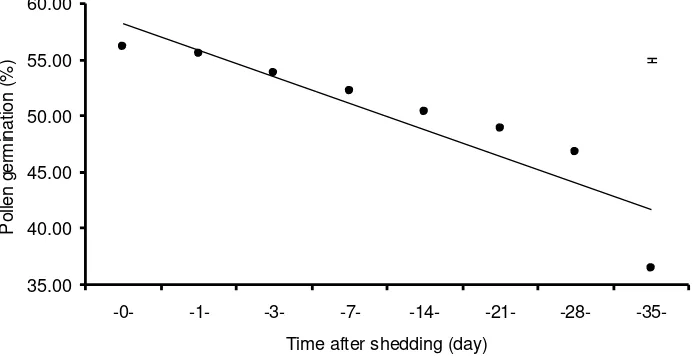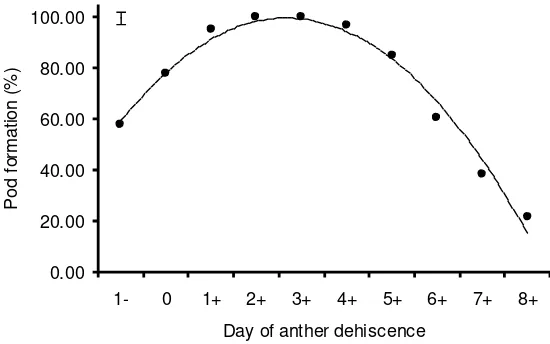Pollen viability and stigma receptivity in Sturt’s desert pea
Z. ZulkarnainA), A. TajiA) and N. PrakashB)
A)School of Rural Science and Agriculture, B)School of Environmental Sciences and Natural Resources Management, University of New England, Armidale NSW 2351, Australia
Abstract. The work reported here was aimed at determining the duration of pollen viability and stigma receptivity in Swainsona formosa (Sturt’s desert pea, an Australian native legume), as an initial step in conventional breeding via artificial crossing by hand pollination. The pollen viability was determined for pollen shed from anthers and retained inside the keel under glasshouse conditions (temperature 25 - 32oC,
light intensity ranging from 650 - 1200 µmol m-2 s-1 and photoperiod 10 – 14 hours) and for pollen
harvested from anthers and stored under cold (4oC) and total darkness conditions. The receptivity of
stigma was determined using stigma on intact plants under glasshouse conditions. The stigmatic surface was exposed and rubbed with fingertips. Pollen from anthers which had just begun shedding was applied to the stigmatic surface one day prior to anther dehiscence, on the day of anther dehiscence and daily thereafter until 8 days after anther dehiscence. The result indicated that pollen grains stored at 4oC
remained fertile up to 21 days after storage (more than 50% of pollen germination was achieved on test solution). The pollen fertility in pollen grain retained inside the flower in the glasshouse declined within 5 days after shedding. The stigma receptivity reached a maximum 2 – 3 days after anther dehiscence and dropped significantly by day 6. The work reported here provides an insight into the correct timing for
hand pollination in Sturt’s desert pea.
Additional keywords: Swainsona formosa, cut flower, legume, plant breeding.
Introduction
Sturt's Desert Pea (Swainsona formosa), an Australian native legume, is of economic interest for its use as an ornamental crop. Its potential as a cut flower plant was first recognised a number of years ago and a large market has been unearthed in Japan.
The plant has large (up to 100 mm long) flag-shaped red flowers, consisting of an upper standard petal with a shiny black boss, and a lower keel containing the sexual organs (Mitchell and Wilcox 1994). Other colour variations, such as white or pink with or without a distinctive boss, have been found. A market survey in Japan in 1989 revealed that flowers with lighter colours were in greater demand than flowers with stronger colours (Barth and Bennel 1989). The flowers consist of clusters (umbels) of up to six florets in a whorl at the end of short upright stalks (Williams and Taji 1987) and the peduncle may measure up to 20 cm long (Jusaitis 1994). Vase life of S. formosa flowers can reach 3 weeks in winter, although it may shorten to 7 - 10 days in summer. At a constant temperature of 23oC, most scapes remain attractive for 10 - 14 days (Kirby 1996).
Materials and methods
Pollen viability
This study consisted of two trials: pollen grains remained on plant (within the keel) in the glasshouse and pollen grains were harvested and kept at a low temperature (4oC) in total darkness. In the first trial, pollen grains were taken from 2 – 3 umbels of 10 glasshouse-grown plants on the day of anther dehiscence (day 0) through 10 days after anther dehiscence (day 10), at daily intervals.
In the second trial, pollen grains were harvested from 2 – 3 umbels from 10 different glasshouse-grown plants on the day of anther dehiscence, collected and mixed in a vial, and immediately refrigerated. The viability of pollen was assessed on the day of harvesting and after up to 28 days of storage.
The germination of pollen was carried out on a modified BK medium (Brewbaker and Kwack 1963) containing 720 ppm Ca(NO3)2·4H2O, 200 ppm MgSO4·7H2O, 200 ppm KNO3, 20 ppm H3BO3 and
10% sucrose. Pollen was spread evenly on the surface of 2 drops of this medium, on microscope slides. The slides were placed in closed Petri dishes on a layer of moistened filter paper. The dishes were kept at room temperature, and pollen germination was assessed after 30 minutes.
Each trial was arranged in a Completely Randomized Design, with 5 replicates. There were 10 fields of vision (observations) on each replicate. The percentage of pollen tube formation was determined by counting the number of pollen forming tubes, divided by all pollen grains, in one field of vision. Data of one replicate were derived from mean values of 10 observations.
Stigma receptivity
This work sought to ascertain the time at which the stigma of S. formosa was most receptive, so that the optimal time for hand pollination (carried out in the glasshouse for breeding purposes) could be determined.
Flower emasculation was undertaken 1 - 2 days prior to anther dehiscence (for practical reasons this was the earliest that floral buds could be manipulated without causing damage). The stigma was rubbed several times with fingertips to remove the stigmatic cuticle and expose the stigmatic surface. The stigmatic surface was pollinated with newly released pollen grains from the same plant, or a different plant, at the time indicated by treatment, i.e. one day before anther dehiscence, on the day of anther dehiscence, one day after anther dehiscence until 8 days after anther dehiscence at daily intervals. Three to five umbels (each consisting of 5 – 7 florets) on each plant were selected as flower samples. Three plants from each treatment were selected as samples.
Results and discussion
Pollen viability
10.00
Figure 1. Germination rate of Sturt’s desert pea pollen grains from day 0 through to day 10 (after shedding), when pollen remained within the keel of flowers on plants in the glasshouse (bar represents SE 2.17).
35.00
Figure 2. Germination rate of Sturt’s desert pea pollen grains from day 0 through to day 35 after shedding, when kept at 4oC in total darkness (bar represents SE 0.23).
Stigma receptivity
practically emasculating and carrying out hand pollination in the present trial was one emasculated glasshouse-grown Sturt’s desert pea flowers (bar represents SE ± 2.35).
Conclusions
These results indicate that hand pollination in Sturt’s desert pea could be done at one day before anther dehiscence, but would optimally be undertaken at 1-5 days after anther dehiscence, at which time the stigma was most receptive. When there were no receptive stigma readily available for pollination, the pollen grains might be left within keel in the glasshouse but just for a short period of no more than 4 days. Alternatively, the pollen grains could be stored at low temperature (4oC) in total darkness, under these conditions pollen viability could remain high for up to 28 days.
References
Barth GE and Bennel M (1989) 'Market Development of Sturt's Desert Pea (Clianthus formosus) for The Cut Flower Market in Japan.' South Australia Department of Agriculture, Adelaide.
Brewbaker JL and Kwack BH (1963) The essential role of calcium ion in pollen germination and pollen tube growth. American Journal of Botany50, 859-865.
Jusaitis M (1994) Floral development and breeding system of Swainsona formosa (Leguminosae).
HortScience29, 117-119.
Kirby GC (1996) Sturt's Desert Pea as cut flower crop. In '4th National Workshop for Australian Flower'.
Perth, Australia pp. 204-209
Mitchell AA and Wilcox DG (1994) 'Arid Shrubland Plants of Western Australia.' (University of Western Australia Press: Nedlands, Australia).
Williams RR and Taji A (1987) Propagation of Sturt's Desert Pea by seed, cutting and tissue culture.
POLLEN VIABILITY AND STIGMA RECEPTIVITY IN
SWAINSONA FORMOSA
Z. ZULKARNAIN, A. TAJI and N. PRAKASH
University of New England, Armidale NSW 2351 Australia zzulkarn@metz.une.edu.au
Introduction
Sturt's desert pea, an Australian native legume, is of economic interest for its use as an ornamental crop. Its potential as a cut flower plant had been recognised for many years ago and proved to be enormous by the fact that it was in demand by the cut flower market in Japan (Barth and Bennel 1989).
The plant has large flag-shaped red flowers consisting of an upper standard petal with a shiny black boss and, a lower keel. Other colour variations were found such as white or pink with or without a distinctive boss (Figure 1). In order to support its commercialisation the breeding program plays an important role in the improvement of flower quality such as more attractive colours, less or no pollen grains, as well as longer vase-life. We studied the pollination as an initial step of conventional breeding of this species. Some basic aspects have been identified and the results are discussed.
Figure 1. White-flowered Sturt's desert pea.
Materials and methods
The viability of pollen grains was assessed in pollen remained within the keel in the glasshouse and those kept in low temperature (4oC)
and total darkness. In the first, pollen grains were taken from the plants on the day of anther dehiscence through 10 days afterwards. In the second, pollen grains were harvested on the day of anther dehiscence and immediately stored in fridge, the viability of pollen was assessed up to 28 days of storage.
Pollen grains were spread evenly on the surface of BK medium (Brewbaker and Kwack 1963) on a microscope slide. The slide was placed in a closed Petri dish on a layer of moistened filter paper. The dish was left at room temperature and pollen germination was assessed after 30 minutes.
For stigma receptivity assessment, flowers were emasculated 1 - 2 days before anther dehiscence. The stigma was pollinated with newly released pollen grains from the same plant or a different plant at a time indicated by treatment, i.e. one day before anther dehiscence until 8 days afterwards in daily intervals. The pod formation was used as an indicator of stigma receptivity.
Results
The viability of pollen grains was relatively high at the time of collection. If pollen grains were left within the keel in the glasshouse, the viability was still reasonably high (> 50% germination) up to 4 days after anther dehiscence. The viability dropped significantly on day 5 when the percentage of germination was less than 40%. Further decrease of viability (less than 20%) was found on day 10 after anther dehiscence (Figure 2). However, if pollen grains were kept at low temperature (4oC ) and total darkness, the viability remained high
(>50%) for up to 21 days of storage (Figure 3). Prolonged storage at
Figure 2. Germination rate of Sturt's desert pea pollen grains from day 0 through to day 10 after shedding when remained within the keel in glasshouse (bar represent SE ± 2.17).
Figure 3. Germination rate of Sturt's desert pea pollen grains from day 0 through to day 35
after shedding when kept under 4oC and total darkness (bar represent SE ± 0.23).
It was found that one day before anther dehiscence the stigma has already been receptive (Figure 4). The receptiveness reached its peak on the days 2 and 3 after anther dehiscence as indicated by 100% pod formation, and began to decrease on day 4. On day 8 after anther dehiscence the petals started to degenerate and the stigma receptiveness decreased significantly and on day 9 the stigma completely lost its receptiveness.
Figure 4. Stigma receptiveness in relation to the timing of anther dehiscence in glasshouse-grown Sturt's desert pea (bar represents SE ± 2.35).
Conclusions
The results indicate that hand pollination in Sturt's desert pea could be done at one day before anther dehiscence, but the best time when the stigma was most receptive was on days 1 to 5 after anther dehiscence. When there was no receptive stigma readily available for pollination, the pollen grains might be left within the keel in the glasshouse but just for a short period of no more than 4 days. Alternatively, the pollen grains could be stored under low temperature (4oC) in total darkness, under which conditions pollen viability could remain high for up to 21 days.
References
Barth GE, Bennel M (1989) 'Market Development of Sturt's Desert Pea (Clianthus formosus) for
The Cut Flower Market in Japan.' South Australia Department of Agriculture, Adelaide.


